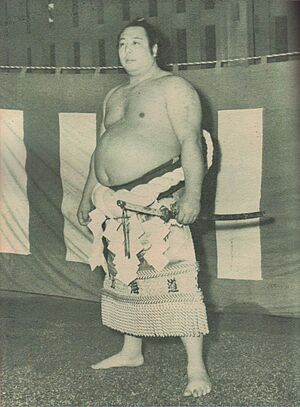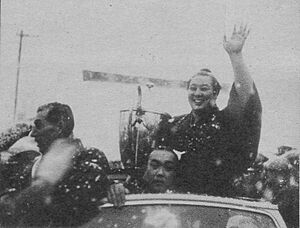Yoshibayama Junnosuke facts for kids
Quick facts for kids Yoshibayama Junnosuke |
|
|---|---|
| 吉葉山 潤之輔 | |

Yoshibayama, circa 1954
|
|
| Personal information | |
| Born | Ikeda Junnosuke April 3, 1920 Hokkaidō, Japan |
| Died | November 26, 1977 (aged 57) |
| Height | 1.79 m (5 ft 10+1⁄2 in) |
| Weight | 143 kg (315 lb) |
| Career | |
| Stable | Takashima |
| Record | 357-171-85-1hold |
| Debut | May, 1938 |
| Highest rank | Yokozuna (January, 1954) |
| Retired | January, 1958 |
| Elder name | Miyagino |
| Championships | 1 (Makuuchi) 1 (Makushita) |
| Special Prizes | Outstanding Performance (3) |
| Gold Stars | 2 (Terukuni) |
| * Up to date as of June 2020. | |
Yoshibayama Junnosuke (Japanese: 吉葉山 潤之輔, April 3, 1920 – November 26, 1977), whose real name was Ikeda Junnosuke (池田 潤之輔), was a famous Japanese professional sumo wrestler. He came from Atsuta District, Hokkaido. He achieved the highest rank in sumo, becoming the 43rd yokozuna.
Even though he faced many injuries and won only one major tournament, Yoshibayama was very popular with sumo fans. He finished second in tournaments five times. He also earned three special awards called special prizes and two gold stars during his time in the top sumo division. After he retired in 1958, he became a sumo coach. He led the Miyagino stable until he passed away in 1977.
Yoshibayama's Sumo Journey
Yoshibayama's start in sumo was quite unusual! He was traveling to Tokyo by train to go to school. But when he arrived, a sumo wrestler met him at the station. This wrestler was expecting a new recruit who had decided not to come. Since Ikeda (Yoshibayama's birth name) was noticeably big, he was mistaken for the new recruit. He was taken to Takashima stable before he even understood what was happening!
He officially began his sumo career in May 1938. At first, he used the ring name, or shikona, Hokutozan Junnosuke (北糖山 潤之輔). After needing emergency surgery for appendicitis, he changed his ring surname to Yoshibayama in May 1939. This was to honor the doctor, Shosaku Yoshiba, who had saved his life.
He was almost promoted to the jūryō division in 1942. However, he was then called to join the Japanese army and fought in World War II. He was seriously hurt during his time in the army. He was shot in the leg twice, and one bullet stayed in his foot forever. For a while, people even thought he had died. When he returned to Japan, he was surprisingly thin. Many sumo experts believe that if he hadn't lost several years of his career due to the war, he would have been an even stronger wrestler for a longer time.
Despite his war injury, Yoshibayama returned to sumo in 1947. He was promoted to the top makuuchi division in November of that year. He stayed in the lower maegashira ranks until September 1950. He was promoted to ōzeki, the second-highest rank, in May 1951. This happened after he finished second in two tournaments in a row, with 13 wins and 2 losses each time, while he was a sekiwake.
In September 1951, Yoshibayama had a special match result called an azukari, or a hold. This happened on the 12th day of the tournament. His opponent, Azumafuji, couldn't stand up anymore. Yoshibayama could have been given the win, but he showed great sportsmanship and insisted on a draw instead. In May 1953, he had an amazing record of 14 wins and only one loss. However, the championship went to an undefeated maegashira named Tokitsuyama, whom Yoshibayama had not fought against.
Yoshibayama was promoted to yokozuna after winning his first championship in January 1954 with a perfect record of 15 wins and 0 losses. However, he struggled at the yokozuna rank at first. He didn't win a single match until the autumn tournament of that year. He was unable to win any more championships as a yokozuna, and only finished second once. Even though he was very popular, he ate and drank too much. This led to several health problems, including issues with his kidneys.
Finally, reaching his physical limit, he announced his retirement during the January 1958 tournament. His old rival Kagamisato, who had been promoted to ōzeki at the same time as Yoshibayama in May 1951, also decided to retire on the same final day. This was the first time that two yokozuna had retired in the same tournament.
Yoshibayama's Fighting Style
Because of the bullet that was still in his ankle, Yoshibayama's fighting style was a bit unpredictable. It also didn't help that his favorite technique was the ketaguri, a leg kick. This move was seen as not proper for a top yokozuna wrestler. However, sumo experts understood that Yoshibayama didn't have much time to learn more traditional sumo techniques because of the years he missed due to the war.
Life After Sumo
After he retired from wrestling, Yoshibayama became the 8th head coach of Miyagino stable. The stable had actually closed after the previous head coach, the 24th yokozuna Ōtori, passed away in 1956. While Yoshibayama was still an active wrestler, he managed his own stable, which is something not allowed today. Ōtori's son-in-law, Fukunosato Ushinosuke, was part of his stable. Yoshibayama officially renamed his stable to Miyagino stable in 1960. He helped train several wrestlers who reached the top division, like Myōbudani.
Yoshibayama also served as a judge for tournament matches. He was also on the board of directors for the Japan Sumo Association. He even opened several chankonabe restaurants, which are still open today!
Another future makuuchi wrestler, Chikubayama, joined his stable. However, Chikubayama had not reached the top makuuchi division by 1977, when Yoshibayama died. Later, Chikubayama became the Miyagino stablemaster and accepted the future yokozuna Hakuhō into the stable.
Yoshibayama performed the yokozuna dohyō-iri (the ring entering ceremony) in the shiranui style. When Hakuhō was promoted to yokozuna, he decided to use Yoshibayama's shiranui style for his own ceremony. On June 1, 2007, at the Meiji Jingu shrine, Hakuhō performed the ring entering ceremony wearing Yoshibayama's keshō-mawashi (ceremonial apron) and used a sword (tachi) that belonged to another yokozuna, Ōtori.
See also
- Glossary of sumo terms
- List of past sumo wrestlers
- List of sumo tournament top division champions
- List of yokozuna



